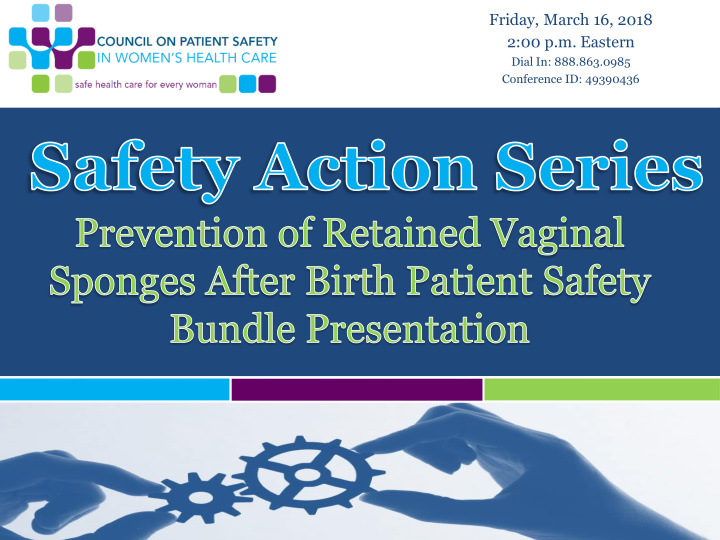



Friday, March 16, 2018 2:00 p.m. Eastern Dial In: 888.863.0985 Conference ID: 49390436 1
Speakers John Keats, MD, CPE National Medical Director, Enterprise Trend Analysis, Cigna Jennifer Frost, MD Medical Director, Health of the Public and Science American Academy of Family Physicians Slide 2 2
Disclosures ➢ John Keats, MD, CPE has no real or perceived conflicts of interest. ➢ Jennifer Frost, MD has no real or perceived conflicts of interest. Slide 3
Objectives ➢ Provide an in-depth overview of the Prevention of Retained Vaginal Sponges After Birth Patient Bundle. ➢ Take a look at the processes, methods, and tools that were used to develop the bundle. ➢ Give suggestions for how to effectively implement and utilize the bundle within your organization. ➢ Identify resources to customize the bundle for use within your organization. Slide 4
Prevention of Retained Vaginal Sponges After Birth Multispecialty Team – Alfred Abuhamad, MD – Paul Gluck, MD – John Keats, MD – Sandra Koch, MD – Barbara Levy, MD – Samuel Smith, MD – George Wendel, MD Slide 5
4 Domains of Patient Safety Bundles • Readiness • Recognition • Response • Reporting/Systems Learning Slide 6
Slide 7
Readiness: Every Unit • Educate all members of the health care team on the importance of preventing retained vaginal sponges. Slide 8
Readiness: Every Unit • Educate all members of the health care team on proper counting and documentation techniques. Slide 9
Readiness: Every Unit • Establish a process for preventing retained vaginal sponges in every birth setting that includes role assignments for all members of the health care team. Use sponge detection system (e.g. pelvic x-ray with radiopaque sponges or radio- frequency identification) when available. Slide 10
Slide 11
Recognition: Every Patient • Perform opening count of all vaginal sponges and record the count in the birth record and in a location visible by all members of the health care team.* *In the event of a precipitous birth, the initial count should be performed immediately after birth before items on table are disturbed (except items immediately necessary for birth). Slide 12
Recognition: Every Patient • Place all used sponges into a separate receptacle or area of table for ease of retrieval during closing count. Slide 13
Recognition: Every Patient • Perform closing count of all vaginal sponges and record the count in the birth record. Slide 14
Recognition: Every Patient • Confirm absence of sponges in the vagina through validation of correct closing count and visual examination/inspection of the vagina and document in the birth record. Slide 15
Slide 16
Response: To an incorrect closing count • Conduct recount of used sponges, carefully search room (all drapes, kick buckets, and linens), and explore vagina, paying attention to vaginal fornicies to identify missing sponges. – If missing sponge is located, record correct closing count in birth record. – If missing sponge remains unaccounted for, utilize sponge detection system to rule out retained sponge. • If missing sponge is located, record correct closing count in birth record. • If missing sponge is not located, or in settings where sponge detection systems are unavailable, record the closing count as incorrect in the birth record and inform the patient of discrepancy in count. Slide 17
Slide 18
Reporting : Unit • Establish a culture of safety and accountability in every birth setting. Slide 19
Reporting : Unit • Develop a process for effectively documenting the sponge count for every birth and informing patient of discrepancies in count. Slide 20
Reporting : Unit • Conduct multidisciplinary review of cases of retained vaginal sponge. Slide 21
Reporting : Unit • Monitor outcome and process metrics. Slide 22
Click to Access Bundle Slide 23
Supporting Resources READINESS • A Multidisciplinary Team Approach to Retained Foreign Objects. The Joint Commission. The Joint Commission Journal on Quality and Patient Safety 2009; 35: 123 – 132. • Irving AV. Policies and Procedures for Healthcare Organizations: A Risk Management Perspective. Patient Safety and Quality Healthcare October 2013. • Agency for Healthcare Research and Quality. Selected Best Practices and Suggestions for Improvement (Agency for Healthcare Research and Quality: Quality Indicators Toolkit) RECOGNITION • Policy for Prevention of a Retained Sponge after Vaginal Delivery. Case Reports in Medicine 2012 • Hospital Council of Northern & Central California. Surgical Safety: Preventing Retained Surgical Items RESPONSE • Gawande AA, et al. Risk Factors for Retained Instruments and Sponges after Surgery. The New England Journal of Medicine 2003; 348: 229 – 235 • Rowlands A. Risk Factors Associated with Incorrect Surgical Counts. AORN Journal 2012 ; 96: 272 – 284. REPORTING/SYSTEMS LEARNING • Centers for Medicare and Medicaid Services. Hospital Inpatient Quality Reporting (IQR) Program Measures • The Joint Commission Sentinel Event Alert: Preventing Unintended Retained Foreign Objects. The Joint Commission October 2013; Slide 24
Q&A Session Press *1 to ask a question You will enter the question queue Your line will be unmuted by the operator for your turn A recording of this presentation will be made available on our website: www.safehealthcareforeverywoman.org Slide 25
Next Safety Action Series Postpartum Care Basics for Maternal Safety: Transition from Maternity to Well-Woman Care Patient Safety Bundle Presentation March 29, 2018 2:00 p.m. Eastern Susan Kendig, JD, WHNP-BC, FAANP Renee Carter, MD Women's Health Integration Specialist, SSM Internist, Health-St. Mary's Hospital, St. Louis, MO Department of Internal Medicine Director of Policy, National Association of Virginia Commonwealth University Health, Nurse Practitioners in Women’s Health Richmond VA Click Here to Register Slide 26
Recommend
More recommend